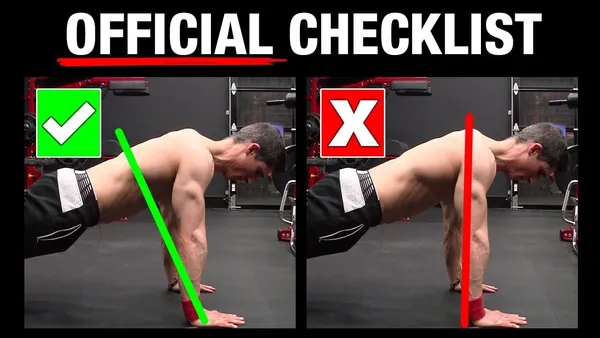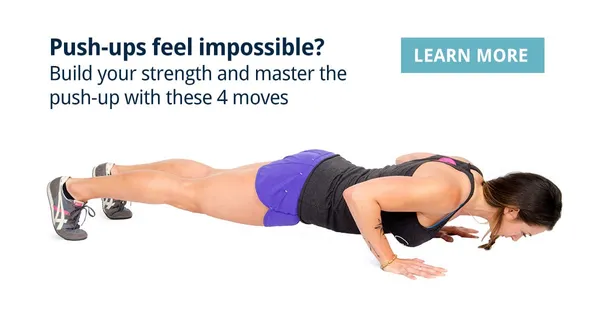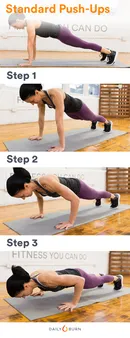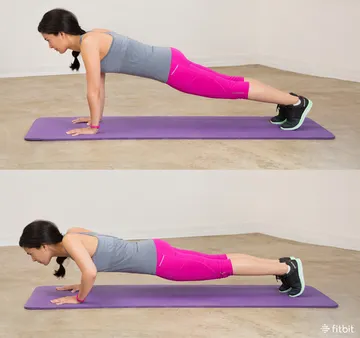Table of Contents
Push-ups are a fundamental bodyweight exercise that engages the muscles of the upper body, improving strength and endurance. With no equipment needed, push-ups can be performed anywhere, making them a staple for fitness enthusiasts of all levels. Whether you're new to exercise or looking to improve your upper body strength, this comprehensive guide from Kizworld will teach you How to do a push-up correctly and effectively.
How to do a push-up with perfect form and engage all muscles
I. How to Do a Push-Up: A Step-by-Step Guide
How to Do a Push-Up: A Step-by-Step Guide
Getting Started: Tips and Precautions
Before embarking on your push-up journey, it's essential to lay the groundwork for success. Begin by warming up your muscles with light cardio and dynamic stretches. This will help prevent injuries and prepare your body for the task ahead. Additionally, ensure you have a comfortable and non-slip surface to perform your push-ups on. If you're a beginner, consider starting with knee push-ups to build strength and confidence gradually.
- Warm up with light cardio and dynamic stretches.
- Choose a comfortable and non-slip surface.
- Start with knee push-ups if you're a beginner.
Correct Push-Up Form
Proper form is paramount when performing push-ups to maximize their effectiveness and minimize the risk of injury. Start by positioning your hands shoulder-width apart, slightly wider than your shoulders. Keep your feet together and your body in a straight line from head to heels. Engage your core and glutes to stabilize your body, and maintain a neutral spine throughout the movement. As you lower your body, bend your elbows and keep them close to your sides. Descend until your chest is almost touching the ground, then press back up to the starting position.
Element | Correct Form | Incorrect Form |
Hand Position | Shoulder-width apart, slightly wider than shoulders | Hands too close together or too far apart |
Body Position | Straight line from head to heels | Arched back or sagging hips |
Core and Glutes | Engaged to stabilize body | Weak or disengaged core and glutes |
Elbow Position | Close to sides, bent at 90 degrees | Elbows flared out or locked out |
Chest Position | Almost touching the ground | Chest too high or too low |
Common Mistakes to Avoid
To ensure you're getting the most out of your push-ups and avoiding potential injuries, steer clear of these common mistakes:
- Rushing the Movement: Take your time and focus on maintaining proper form throughout each repetition.
- Not Engaging Your Core: A strong core is crucial for stabilizing your body and preventing lower back pain.
- Flaring Your Elbows: Keep your elbows close to your sides to target the chest muscles effectively.
- Locking Out Your Elbows: Avoid locking your elbows at the top of the movement to protect your joints.
- Arching Your Back: Maintain a neutral spine to prevent strain on your lower back.
By avoiding these common pitfalls, you'll be well on your way to mastering the push-up and reaping its numerous benefits.
Check out our related articles on The Benefits of Push-Ups and How to Improve Your Push-Up Form and Technique for more in-depth information.
II. Benefits of Push-Ups
Benefits of Push-Ups
Push-ups are a fundamental bodyweight exercise that engages the muscles of the upper body, improving strength and endurance. With no equipment needed, push-ups can be performed anywhere, making them a staple for fitness enthusiasts of all levels. Whether you're new to exercise or looking to improve your upper body strength, this comprehensive guide from kizworld will teach you how to do a push-up correctly and effectively.
The benefits of push-ups are numerous. They help build muscle mass in the chest, shoulders, triceps, and back. Push-ups also improve core strength and stability, which is essential for good posture and balance. Additionally, push-ups can help increase flexibility in the shoulders and wrists. For those looking to lose weight, push-ups are a great way to burn calories and boost metabolism.
- Build muscle mass in the chest, shoulders, triceps, and back.
- Improve core strength and stability.
- Increase flexibility in the shoulders and wrists.
- Burn calories and boost metabolism.
Push-ups are a versatile exercise that can be modified to suit different fitness levels. Beginners can start with knee push-ups, which are performed with the knees on the ground. As you get stronger, you can progress to full push-ups, which are performed with the feet on the ground and the body in a straight line from head to heels. There are also many variations of push-ups that can be used to target different muscle groups and challenge yourself.
If you're new to push-ups, it's important to start slowly and gradually increase the number of repetitions you can do. It's also important to focus on proper form to avoid injury. Make sure to keep your back straight, your core engaged, and your elbows close to your body as you lower and raise your body.
With regular practice, you'll be able to master the push-up and enjoy all the benefits it has to offer. So what are you waiting for? Start doing push-ups today!
How to Do a Handstand: A Step-by-Step Guide for Beginners
III. Getting Started: Tips and Precautions
Before you start doing push-ups, there are a few things you should keep in mind.
- Warm up: Always warm up before doing push-ups to prepare your muscles for the exercise. This can be done by doing some light cardio, such as jogging or jumping jacks, for a few minutes.
- Start slowly: If you're new to push-ups, start with a few repetitions and gradually increase the number as you get stronger.
- Focus on form: It's important to focus on proper form to avoid injury. Make sure to keep your back straight, your core engaged, and your elbows close to your body as you lower and raise your body.
- Listen to your body: If you feel pain, stop doing push-ups and consult with a doctor or physical therapist.
By following these tips, you can safely and effectively incorporate push-ups into your workout routine.
The Benefits of Gymnastics for Kids: A Guide for Parents
IV. Common Mistakes to Avoid
Common Mistakes to Avoid
While push-ups are a fundamental exercise, there are a few common mistakes that can hinder your progress and potentially lead to injury. Here are some pitfalls to watch out for:
- Incorrect Form: Failing to maintain proper form during push-ups can strain your muscles and joints. Ensure your body forms a straight line from head to heels, with your core engaged and your back flat.
- Overexertion: Starting with too many push-ups or increasing the repetitions too quickly can lead to muscle fatigue and potential injury. Gradually increase the number of push-ups as you build strength and endurance.
- Neglecting Warm-Up and Cool-Down: Skipping a warm-up before and a cool-down after your push-up routine can increase the risk of muscle strains and injuries. Dedicate a few minutes to dynamic stretches and light cardio to prepare your body for the exercise and to aid in recovery afterward.
- Ignoring Breathing Technique: Proper breathing is crucial during push-ups. Exhale as you lower your body and inhale as you push back up. Holding your breath can strain your cardiovascular system and limit your performance.
- Incorrect Hand Placement: The position of your hands significantly impacts the muscles engaged during push-ups. Keep your hands shoulder-width apart, slightly wider than your shoulders for a more challenging variation, and ensure your wrists are aligned with your elbows.
By avoiding these common mistakes, you can maximize the benefits of push-ups while minimizing the risk of injury. Remember to listen to your body and modify the exercise as needed to suit your fitness level and goals.
If you're new to push-ups or looking to improve your form, consider working with a qualified fitness instructor or personal trainer. They can provide personalized guidance and ensure you're performing the exercise correctly and safely.
Check out our related articles on how to do a handstand and the benefits of gymnastics for kids for more fitness inspiration.
V. Variations of Push-Ups
Variations of Push-Ups
The classic push-up is just the tip of the iceberg when it comes to this versatile exercise. With a few tweaks, you can target different muscle groups and challenge yourself in new ways. Here are some popular variations:
- Decline Push-Ups: Elevate your feet on a bench or step to increase the challenge. This variation places more emphasis on the upper chest muscles.
- Incline Push-Ups: Lower your feet onto a bench or step to make the exercise easier. This variation is good for beginners or those with weaker upper body strength.
- Wide-Grip Push-Ups: Spread your hands wider than shoulder-width apart. This variation targets the outer chest muscles.
- Close-Grip Push-Ups: Place your hands closer together than shoulder-width apart. This variation targets the triceps.
- Single-Leg Push-Ups: Lift one leg off the ground and perform the push-up with the other leg extended. This variation challenges your balance and core strength in addition to your upper body muscles.
- Plyometric Push-Ups: Explosively push yourself up off the ground and clap your hands together at the top of the movement. This variation adds a plyometric element to the exercise, which can help improve power and speed.
Variation | Muscles Targeted | Benefits |
Decline Push-Ups | Upper chest | Builds strength and definition in the upper chest muscles. |
Incline Push-Ups | Lower chest | Helps to build strength and definition in the lower chest muscles. |
Wide-Grip Push-Ups | Outer chest | Targets and strengthens the outer chest muscles. |
Close-Grip Push-Ups | Triceps | Builds strength and definition in the triceps. |
Single-Leg Push-Ups | Balance, core, and upper body | Challenges balance, core strength, and upper body strength. |
Plyometric Push-Ups | Power and speed | Incorporates a plyometric element to improve power and speed. |
These are just a few of the many push-up variations that you can try. Experiment with different variations to find the ones that you enjoy the most and that challenge you the most.
Ready to take your push-ups to the next level? Check out our related guide on How to Do a Handstand for even more upper body strength-building exercises.
VI. Conclusion
Push-ups are a versatile and effective exercise that can be tailored to your fitness level and goals. Whether you're a beginner looking to build a strong foundation or an experienced athlete seeking a challenge, push-ups offer endless possibilities for progression. Remember to focus on proper form, engage your core, and breathe deeply throughout the movement. With dedication and consistency, you'll unlock the full potential of push-ups and reap the benefits of a stronger, more defined upper body.